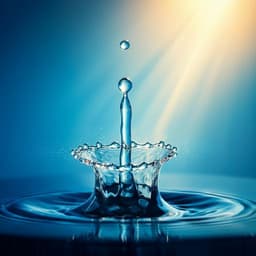
Engineering and Technology
Highly efficient and salt rejecting solar evaporation via a wick-free confined water layer
L. Zhang, X. Li, et al.
Discover how Lenan Zhang and colleagues achieved over 80% solar-to-vapor conversion efficiency and effectively tackled salt accumulation in solar evaporation. Their innovative wick-free confined water layer enhances efficiency, making solar evaporation applications more feasible and cost-effective!
~3 min • Beginner • English
Introduction
Water scarcity affects two-thirds of the global population, motivating efficient solar-driven evaporation for passive vapor generation, desalination, wastewater treatment, and sterilization. Thermally localized interfacial solar evaporators often rely on capillary wicks, but salt accumulation is a fundamental challenge due to the low diffusivity of salt in water, leading to fouling, reduced rates, and reliability issues. Wick-based devices add transport resistance for salt diffusion and suffer clogging/crystallization under high flux or long operation. Contactless solar evaporation removes wicks and shows excellent salt rejection and even superheating, but suffers increased heat loss to bulk water and lower efficiency. Thus, a core problem is breaking the tradeoff between thermal localization and salt rejection by using a moderate water confinement. Two key questions are posed: (1) how to passively initiate convective flow to overcome diffusion-limited salt rejection, and (2) how to balance the interplay between thermal localization and salt rejection when convection also increases heat loss, aiming for a regime maximizing salt rejection with minimal heat penalty. The work aims to design a simple, low-cost evaporator achieving simultaneous thermal localization and salt rejection by leveraging a wick-free confined water layer and engineered natural convection, supported by a coupled mechanistic model and experiments.
Literature Review
Interfacial solar evaporation with wick structures enables high efficiency via localized heating but is hindered by salt accumulation and fouling. Prior approaches to mitigate salt include separation-by-function architectures and enhanced diffusion via macroporous designs, which improve performance yet struggle with high-salinity brines and long-term stability. Contactless solar evaporation localizes heat at the water surface via IR absorption without contact, achieving strong salt rejection and superheated steam, but reported efficiencies (~43%) lag behind wick-based systems (>60%) due to heat loss in unconfined bulk water. Bio-inspired confined water layers (~mm-thick) within 3D printed or hydrophobic porous structures have shown improved salt rejection, but a simple pathway to simultaneously localize heat and reject salt remained elusive due to limited understanding of salt transport under evaporation. Prior work also explored Marangoni and unidirectional flows for convective enhancement, and various materials (hydrogels, graphene-based absorbers, photothermal papers) for high rates, but with persistent salt and/or heat-loss tradeoffs.
Methodology
Design: A wick-free, self-floating confined water layer is created using a neutrally buoyant thermal insulation that rides with the water-air interface. Vertical macrochannels through the insulation connect the top confined layer to the bulk reservoir, enabling passive natural convection driven by salinity-induced density gradients while impeding heat loss.
Prototype: Insulating ring (polystyrene foam, ~2.5 mm thickness, 6 mm height); floating insulation (polyurethane foam, 36 mm diameter, 25 mm thickness); five macrochannels (optimized diameter 2.5 mm); balancing weight (copper plate, 36 mm diameter, total ~23.4 g); solar absorber: black paint (95.3% absorptance) applied to top of floating insulation for normal mode; for contactless mode, a separate double-sided black-painted aluminum absorber above the water layer; a convection cover (two 45 mm diameter glass slides, 2 mm thick, 5 mm air gap) used where noted.
Geometry optimization (model + experiments): Macrochannel diameter tuned to leverage different heat and mass diffusivities (Ds ~1e-9 m2/s vs thermal diffusivity ~1e-7 m2/s). Convection significance assessed via Peclet numbers. Optimal range found where mass transport is convection-dominated while heat transport remains conduction-dominated (Pe_mass>1, Pe_therm<1). Selected d=2.5 mm (onset of salt-convection) while avoiding heat-convection onset (~3.5 mm). Confined layer thickness chosen as 5 mm to minimize in-plane nonuniformity and sidewall heat losses; macrochannel arrangement: one central and four at 9 mm spacing for improved uniformity; insulation thickness 25 mm.
Modeling: Fully coupled, time-dependent 3D model (COMSOL) solving mass conservation and Navier–Stokes with brine density dependent on salinity and temperature, and convection–diffusion for heat and salt. Boundary conditions: uniform heat flux at absorber; evaporative flux at water-air interface (calibrated mass/heat transfer coefficients); natural convection heat loss coefficient included; salt flux at interface set by evaporative flux and bulk salinity; no-flux elsewhere. Mesh ~386,000 nodes; mesh-independence verified. Dripping tests modeled by initializing a uniform 20 wt% brine layer atop the confined water layer.
Experimental setups: Laboratory one-sun (1000 W/m2) solar simulator with aperture; thermal insulation around reservoir with reflective foil to confine illumination; mass loss measured by digital balance; temperatures by IR camera and thermocouples (confined layer, bulk water ~2 cm below insulation, ambient). Three configurations tested: (1) normal mode (absorber at confined layer), (2) normal mode + convection cover, (3) contactless mode (absorber separated by air gap with convection cover). Dark evaporation characterized separately and subtracted. Solar-to-vapor efficiency computed from solar-driven mass flux and latent heat. Salinity measured by digital refractometer sampling 100 µL at the interface. Outdoor test: two side-by-side devices (configurations 2 and 3) with pyranometer recording solar flux; wind-induced convection present, convection cover used.
Stability and dynamics: Mechanical stability checked by displacing the float ~1.6 cm and tracking return dynamics; modeled as a buoyancy-driven damped oscillator. Reliability assessed via week-long cycling (8 h illuminated + 16 h dark per day) on 20 wt% brine with slow DI feed from reservoir bottom to avoid bulk saturation.
Key Findings
- Identified and validated a convection window enabling simultaneous thermal localization and salt rejection in a wick-free confined water layer. Modeling shows salt-transport convection onset at macrochannel diameter ~2.5 mm, while heat-convection onset near ~3.5 mm, producing a design window (2.5–3.5 mm) where salt rejection is convection-dominated and heat loss remains conduction-dominated.
- Natural convection markedly accelerates salt removal from the confined layer: Dripping 2.3 mL of 20 wt% brine in isothermal conditions showed rapid salinity decay consistent with model; food dye visualization confirmed faster transport for dense brine vs DI water.
- Thermal localization: Under one sun, confined layer temperature reached ~40 °C in normal mode without thermal circulations, consistent with a linear temperature gradient across insulation. Contactless mode absorber reached ~60 °C, with confined water ~10 °C above ambient.
- Laboratory evaporation performance (one sun, DI water): Configuration 1 (normal mode): 1.36 L m−2 h−1, η=91%. Configuration 2 (with convection cover): 1.30 L m−2 h−1, η=87% (slight reduction due to vapor transport resistance and optical losses). Configuration 3 (contactless): 0.75 L m−2 h−1, η=51%, exceeding prior contactless reports (~43%).
- Brine tolerance and efficiency: No crystallization for 3.5–20 wt% brine over 6 h; for 20 wt% brine, η remained >80%. Pushing to 25 wt% (near saturation), 6 h achieved 67% efficiency without crystallization. The confined layer salinity shows an initial rise then a quasi-steady state; transition occurs faster at higher bulk salinity (e.g., ~0.5 h for 20 wt%). Highest observed salinity after 6 h was 23.3 wt%, below saturation (26.3 wt%).
- Reliability: Over 7 cycles (8 h on/16 h off per day) with 20 wt% brine, mass change rate and confined layer salinity (average 21.7 wt%) remained stable; average mass loss rate ~1.06 g h−1 for the tested device area; no fouling or crystallization observed.
- Outdoor validation (East Setauket, NY): Average solar flux ~595 W m−2 over 5 h. Configuration 2 maintained >10 °C temperature rise over ambient; configuration 3 absorber peaked ~50 °C with confined layer ~10 °C above ambient. Evaporation rates (including dark evaporation): 0.91 L m−2 h−1 (configuration 2) and 0.55 L m−2 h−1 (configuration 3), comparable to lab performance.
- Cost and materials: Prototype built from low-cost, readily available foams and paints with estimated material cost ~$2.5–3.9 per m2 (using concrete/brick potential for ballast). Solar absorptance ~95.3%.
Discussion
The study demonstrates that by moderately confining water and engineering macrochannel-driven natural convection, one can decouple and simultaneously optimize salt rejection and thermal localization, overcoming the traditional tradeoff in wick-based and contactless approaches. The key physical insight is exploiting the two-order-of-magnitude disparity between salt mass diffusivity and water thermal diffusivity to select a flow regime where convective transport dominates salt removal but not heat transfer. Experiments and models align across thermal, fluidic, and salinity dynamics, confirming that salt is efficiently flushed from the confined layer while conductive heat transport preserves high thermal localization. The approach also generalizes: integrating the confined layer with a contactless absorber improves contactless efficiency to ~50% under one sun and raises absorber temperatures for potential superheated steam applications. The self-floating design decouples solar absorption, insulation, and water supply, relaxing material constraints, enabling simple, low-cost construction. The results provide quantitative design guidelines (macrochannel size/spacing, layer thickness, insulation thickness) and show robust operation across brine salinities up to 20 wt% (and short-term at 25 wt%) without crystallization, both in laboratory and outdoor conditions.
Conclusion
This work presents a wick-free, self-floating confined water layer that achieves simultaneous thermal localization and salt rejection through passively triggered natural convection. A fully coupled mechanistic model guided the design of macrochannels and layer geometry to enter a regime where salt transport is convection-dominated while heat loss remains conduction-dominated. The prototype reaches high solar-to-vapor efficiencies (up to 91% for DI water in normal mode; >80% for 20 wt% brine) and enhances contactless mode efficiency to ~50%, with stable week-long operation and no crystallization at high salinities. The design is simple, low-cost, and compatible with diverse solar evaporator architectures. Future work includes scaling and long-term field trials, exploring materials and geometries for further heat-loss minimization, integrating with high-temperature and wastewater treatment applications, and investigating biofouling resistance leveraging induced convective flow. The model-driven framework offers generalizable guidelines for fluidic engineering in solar evaporation systems.
Limitations
The study primarily evaluates small-scale prototypes under controlled one-sun laboratory conditions and a single-day outdoor test; long-term field performance, diverse climates, and scaling effects are not fully addressed. The contactless mode efficiency, while improved, remains below that of optimized normal-mode devices. The modeling framework relies on calibrated coefficients (e.g., evaporative heat/mass transfer), and material durability or biofouling behavior over extended deployments requires further investigation. Wind-induced convective losses necessitated a convection cover outdoors, indicating sensitivity to environmental conditions and potential added optical resistance.
Related Publications
Explore these studies to deepen your understanding of the subject.







